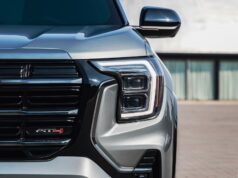The 2013 Ford Fusion and Fusion Hybrid have received a five-star top vehicle safety rating from the National Highway Traffic Safety Administration (NHTSA).

The 2013 Ford Fusion and Fusion Hybrid have received a five-star top vehicle safety rating from the National Highway Traffic Safety Administration (NHTSA). The Fusion and Fusion Hybrid received a five-star Overall Vehicle Score in NHTSA New Car Assessment Program (NCAP) testing, which combines vehicle performance in frontal and side-impact crash tests and resistance to rollover.
The new five-star safety award from NHTSA is in addition to the 2013 Fusion being named a Top Safety Pick+ from the Insurance Institute for Highway Safety (IIHS) last month. The Top Safety Pick + designation is the highest rating the organization has for vehicle safety.
The 2013 Fusion and Fusion Hybrid’s top safety rating can be attributed to Ford’s new Personal Safety System, which is a network of components that work together to tailor the deployment of the front airbags during frontal collisions. The restraint control module (RCM) translates information collected by the front crash sensors, front outboard safety belt buckle switches, driver-seat track position and passenger seat weight sensor. Using this information, the RCM activates the safety belt pretensioners and determines how the dual-stage front airbags will deploy. This tailored airbag deployment is based upon system inputs received about the size, seat track position and safety belt usage of the front seat occupants.
The redesigned seat-mounted side airbags deploy lower in the pelvis area and incorporate new venting technology. The side airbag’s venting technology takes into account the size of the occupant, and varies the pressure so smaller occupants receive a lower pressure.
The tunnel vent is lined up with the shoulder area of the occupant. On larger passengers, the shoulder engages the vent and keeps it from venting so the gas stays inside the airbag. On smaller passengers, the effect is just the opposite: Because the occupant’s shoulder is below the vent, the gas vents out of the airbag.
The driver’s airbag uses a reconfigured curve-shaped tether system that pulls in the lower section to create a pocket that help to lessen the impact of the airbag on the driver’s chest and ribs in frontal crashes. Deploying at the same time is a driver’s knee airbag.









